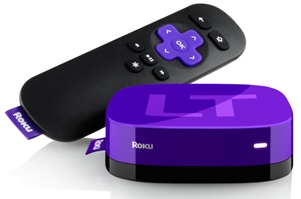 A Roku lending program launched last year by Ephrata Public Library (EPL) in Pennsylvania has proven so popular that the library is planning to invest in several more of the media streaming devices in the coming months.
A Roku lending program launched last year by Ephrata Public Library (EPL) in Pennsylvania has proven so popular that the library is planning to invest in several more of the media streaming devices in the coming months.
“We’re adding our third and our fourth [soon], and I would say this year, we will probably add six to eight,” said EPL Executive Director Penny Talbert. “There are always holds on them, and they’re circulating for a week.”
EPL purchased two Rokus last Spring at the suggestion of the library’s technology manager Laura Brandt. As Talbert noted, the units didn’t require a huge initial investment to try. The basic Roku LT units cost $50. For each unit, the library purchases dedicated subscriptions to Netflix and/or Hulu Plus, which currently cost $7.99 per month each, as well as other content from TED, Allrecipes.com, the BBC, and other sources. Subscriptions are set up so that patrons can’t use EPL’s account to make additional purchases while they have the units.
For comparison’s sake, Talbert noted that the total cost of the Roku and a dedicated subscription is less than libraries pay for content in many other formats. Many individual ebooks, audiobooks, or single seasons of a television series on DVD cost more than one Roku unit, she said.
“If that television series is available on Hulu, do the math. It’s not only cost savings, but space savings, and what you can offer your patrons. …This is a great way to send, basically, 100,000 movies home with a patron.”
Likewise, the Roku lending program may be a stopgap relevant to the concerns of librarians who worry about the increasing push toward streaming-only content, such as the much buzzed-about “House of Cards” remake debuted recently by Netflix. In attempt to compete with premium content creators like HBO, Netflix has in the works a number of programs available only to its streaming service customers, many of which may never become available on traditional physical media like DVDs.
 Upon checkout, patrons receive the Roku unit, its remote and power cord, and an HDMI cable. EPL produced a video with straightforward setup instructions, which patrons can view on the EPLDigitalLibrary section of their website. So far, most patrons haven’t needed much help, Talbert said.
Upon checkout, patrons receive the Roku unit, its remote and power cord, and an HDMI cable. EPL produced a video with straightforward setup instructions, which patrons can view on the EPLDigitalLibrary section of their website. So far, most patrons haven’t needed much help, Talbert said.
“I’m really surprised how few problems we’ve had with people hooking them up to their televisions. [Brandt] made the videos and we were prepared for this, but I still expected to get lots of calls from people asking how to hook it up to their wireless, or how to hook it up to their TVs.”
There are drawbacks. Loaning out one Roku for a week could diminish the circulation of other media—potentially multiple DVDs. Streaming movies will require a broadband connection, which many patrons may not have at home. And, although the matter has not been challenged in court, there have been debates about whether library programs that involve Netflix or similar consumer lending programs may violate those companies’ terms of service. Talbert said that the library has read the terms of service for the content providers carefully, and believes that EPL is in compliance, due to the maintenance of dedicated subscriptions for each device, and the fact that EPL does not use the devices to broadcast content to public audiences within the library.
Regardless, those providers, along with Roku, may be pleased to learn that after the library introduces them to the technology, many EPL patrons decide to buy their own units and presumably their own subscriptions. Yet that trend could also have an uncertain impact on the library’s media circulation in the future.
But, delivering content and introducing patrons to the latest content delivery technology are both important components of the library’s mission, Talbert said.
“That’s one of the ways we prove our value. We know more about technology than most people coming through our doors, and our job is to help educate them.”
As for the program’s potential impact on media circulation, “it is tough,” she said. “Oftentimes your funding is tied to circs, and that is an impressive number to be able to hand out to your local funding bodies, whoever that might be. So it’s important, but at the same time, it’s not important enough to keep things away from patrons.”


